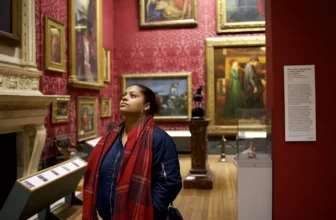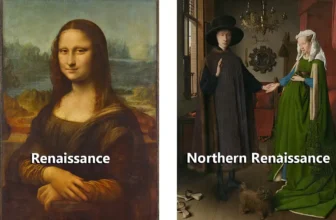A Surrealist Masterpiece of Time and Symbolism
Rene Magritte, Personal Values Painting
Rene Magritte, one of the leading figures of the Surrealist movement, is known for his deeply philosophical, dreamlike artworks that question the nature of reality, perception, and meaning. Among his many enigmatic creations, Personal Values (Les valeurs personnelles, 1952) stands out as one of the most intellectually rich and visually arresting paintings. This artwork challenges the viewer’s sense of space, scale, and familiarity, prompting a deeper reflection on the objects and values that define personal identity.
In this story post, we will delve into the essence of Personal Values, examining what the painting is all about, who painted it and how, its symbolism and interpretation, what is visually happening in the piece, the type of art it represents, and where this painting resides today. The goal is to unpack the complex themes Magritte embedded within this extraordinary canvas and to offer insights that enhance our understanding of his unique artistic vision.
Who Was Rene Magritte?
Before exploring the painting itself, it’s important to understand the artist behind it. Rene Magritte (1898–1967) was a Belgian Surrealist painter renowned for his clever and provocative images that force the observer to look beyond the surface. Born in Lessines, Belgium, Magritte’s early career included training at the Académie Royale des Beaux-Arts in Brussels. Like many Surrealists, he was influenced by Freudian psychoanalysis, dreams, and the irrational aspects of the subconscious.
However, Magritte’s approach to Surrealism differed from contemporaries like Salvador Dalí. Where Dalí focused on hyper-realistic depictions of dreamscapes and unconscious fantasies, Magritte often used ordinary, everyday objects placed in unusual contexts to subvert logic and stir philosophical inquiry. His work is often described as “poetic realism”, marrying realistic technique with impossible scenarios.
What Is Personal Values All About?
Personal Values, painted in 1952, is a large oil-on-canvas work that depicts a bedroom interior filled with disproportionately oversized everyday objects. These items include a comb, a shaving brush, a matchstick, a bar of soap, a glass of water, and a tube of toothpaste, each magnified to an absurd scale that dwarfs the furniture around them.
At first glance, the scene appears somewhat coherent, a traditional bedroom setting with walls, floorboards, a dresser, and a bed. However, the oversized personal hygiene items loom with unsettling prominence. The scale distortion forces viewers to reevaluate the relationship between space and object, value and utility.
The painting’s name, Personal Values, encourages viewers to consider the significance we assign to common items in our lives, how these objects might reflect our identity, memory, and psychological landscape.
How and When Was Personal Values Painted?
Magritte completed Personal Values in 1952, during a mature phase of his career when he had firmly established his surrealistic language. The painting was executed in oil on canvas and showcases Magritte’s signature style: precise brushwork, clarity of form, and a calculated use of lighting that mimics natural realism even as it depicts impossible scenes.
Magritte was known for working from sketches and notes, carefully planning his compositions before committing them to canvas. Unlike the spontaneous, automatic techniques favored by other Surrealists, Magritte preferred a deliberate, cerebral approach, making his work both intellectually rigorous and visually impactful.
What Is Happening in the Painting?
The composition of Personal Values is simple yet deeply perplexing. The scene features a conventional bedroom with wooden floorboards and wallpapered walls, yet it is dominated by five or six vastly enlarged toiletry items. Each object, though completely normal in its design, is absurd in its scale. A matchstick reaches from the floor to the ceiling. A comb lies across the wall like a beam. A bar of soap rests atop a cabinet, nearly the size of a mattress.
Despite their monumental size, the objects are rendered with realistic precision. There is no distortion in perspective or shape, only scale. This contrast between realism and impossibility generates a cognitive dissonance that is both humorous and disorienting.
One particularly striking aspect of the painting is that the room’s walls seem transparent. Instead of a solid background, we see a cloudy blue sky behind the walls, as if the interior is exposed to the elements, or perhaps even suspended in the sky. This evokes a common theme in Magritte’s work: the conflation of interior and exterior space, blurring the line between inside and outside, dream and reality.
Symbolism and Interpretation of Personal Values
The title of the painting, Personal Values, suggests that the objects depicted are not merely physical items but are imbued with emotional or symbolic weight. Let’s examine a few interpretive layers:
1. Disproportion as a Commentary on Psychological Importance
By enlarging everyday items, Magritte may be suggesting that the importance we place on certain objects is not related to their physical size or utility, but rather to their psychological or emotional significance. A shaving brush or a comb, for instance, might seem trivial, but for an individual, they could carry deep personal meaning tied to routines, memories, or even identity.
2. Subversion of Domestic Norms
The bedroom is a space associated with privacy, intimacy, and routine. By filling this space with grotesquely oversized objects, Magritte disrupts the sanctity of this personal environment. It’s as if our subconscious is overwhelming the neat, controlled aspects of daily life, imposing irrational values onto our most familiar surroundings.
3. Sky as a Symbol of Freedom or Imagination
The surreal substitution of the room’s wallpaper or wall with a sky motif evokes a recurring Magritte symbol: the sky as a stand-in for the infinite, the subconscious, or the imaginative realm. This may suggest that the room is not a literal space, but a mental one, a reflection of the psyche, populated with “personal values” magnified by thought or memory.
4. Identity and Material Possessions
Another reading of Personal Values could focus on the relationship between personal identity and material belongings. Do we define ourselves by the objects we use every day? Are these items extensions of our personality, habits, or culture? In the painting, the absence of any human figure makes the objects more symbolic of presence than absence, echoes of someone who once inhabited the space.
Art Style and Techniques: Surrealism Meets Realism
Personal Values is firmly situated within the Surrealist movement, but Magritte’s take on Surrealism is highly distinctive. While most Surrealists employed dream logic and automatism to delve into the unconscious, Magritte used a more controlled and analytical approach. He painted in a realistic style, often employing illusionistic techniques to create highly detailed images, but always placing these realistic depictions in impossible contexts.
The paradox in Personal Values is thus twofold: the realistic depiction of unrealistic phenomena, and the use of logic to portray the illogical. The clean, meticulous brushstrokes contrast with the irrational scale of the objects, creating a unique tension between familiarity and strangeness.
The painting could also be seen as an exploration of “magical realism”, though this term is more often used in literature. Magritte’s works often place the extraordinary within the context of the mundane, subtly suggesting that the magical or surreal is never far from everyday life.
What Kind of Art Is This?
Magritte’s Personal Values is a Surrealist painting, but it also bridges several artistic modes:
Conceptual Art – The work prioritizes ideas over form, provoking thought more than aesthetic pleasure.
Illusionism – Magritte uses classical techniques of light, shadow, and perspective to create the illusion of reality.
Psychological Portraiture – Though not a portrait in the traditional sense, the painting reflects inner psychological states and values, acting almost as a psychological self-portrait without the presence of a human subject.
It is an artwork that not only represents a surreal environment but actively interrogates reality, inviting viewers to engage with the act of interpretation itself.
Where Is Personal Values Painting Located Today?
Personal Values painting is housed at the San Francisco Museum of Modern Art (SFMOMA) in San Francisco, California. The painting is part of the museum’s permanent collection and is often featured in exhibitions that explore Surrealism, 20th-century art, or thematic displays on identity and perception.
SFMOMA is one of the leading institutions in the United States for modern and contemporary art, and its inclusion of Personal Values underscores the painting’s significance in the broader canon of modern art history.
Legacy and Influence
Personal Values continues to inspire artists, critics, philosophers, and viewers decades after its creation. The painting is frequently cited in discussions of how art can visualize abstract concepts like identity, memory, and subjective importance. It also resonates with postmodern themes, questioning objectivity, highlighting the relativity of meaning, and dismantling traditional hierarchies of significance.
In many ways, Personal Values anticipates later movements like Pop Art and Conceptual Art, which similarly explore consumer goods, ordinary objects, and their symbolic power. Artists like Andy Warhol, Claes Oldenburg, and Jeff Koons owe an intellectual debt to Magritte’s surreal manipulations of the everyday.
What Does Personal Values Teach Us?
Magritte once said, “Art evokes the mystery without which the world would not exist.” In Personal Values, he evokes mystery not through fantastical monsters or dreamscapes but through the manipulation of scale, setting, and context. The painting teaches us that meaning is not inherent in objects but assigned, often irrationally, by personal experience, emotion, and memory.
In an era increasingly obsessed with minimalism and decluttering, Personal Values serves as a counterpoint: a reminder that the mundane can be monumental, and the small can carry enormous weight in the theater of the human psyche.
By disorienting our sense of reality, Magritte asks us to look more closely, not just at art, but at life itself. In doing so, he affirms the enduring power of surrealism to unlock hidden dimensions of experience and value image/wikiart




